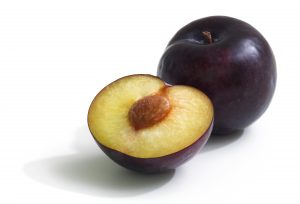Damsons in distress
As summer draws to a close and grouse all over Britain duck for cover, let’s take a closer look at one of our most underrated fruits, the swan song of the season that packs a fruity punch. There should be no Marjories or Victorias left wondering if they will become old prunes or face a sticky end in the jam pot!
Plums are traditionally the last fruit of summer and the first fruit of autumn. Referred to in the writings of Chaucer, they are a truly British fruit not least because they nurture the nation’s idiosyncratic nature.
Every early September they are like the long-lost friend that comes to visit, either greeted with utter relish and devoured on the spot or treated with an initial disdain, then later consumed in the guise of a jam, chutney or a form of baked pudding. Well I think that the humble plum can offer us a bit more than a breakfast preserve, they are somewhat of a national obsession in France where they consume 40 million a year, mostly in a clafoutis I am guessing!
When ripe they are wonderfully sweet, with a rich complex flavour and the other brilliant thing about plums is, rather like beetroot, it doesn’t matter if you are not a fan of the raw product. Incorporated in a cobbler or served alongside duck as a sauce, the taste is far more subtle. Rich and tangy, without the sharpness of the raw fruit. The drawback is that you either can’t seem to find a British plum anywhere or you are overwhelmed by them.
Unfortunately, due to imported produce having a higher profit margin, many supermarkets tend to sell Californian Santa Rosa plums or something similar, but you just can’t beat a good old British plum for texture and taste. For one, they are local, fresh and not suffering from jet lag from the long journey over the Atlantic! You can eat plums from July to the end of September depending on variety. The most popular in the UK being damson and Victoria. If you are fortunate enough to live near Burnham Market then go to Plumbe & Maufe [http://www.pmfarming.co.uk], they have 3,000 plum trees and 36 varieties.
Foraging of course, is another option. Carefully scoured hedgerows, particularly in the North can often yield a good haul of wild plums. The wild plum tree is very similar to the blackthorn, about six metres high with dark oval leaves and the fruit is usually ripe by the end of September. Wild plums are dark purple with juicy, green flesh.
Plums are just as good a component of savoury dishes as they are of sweet ones. A plum sauce can enhance the flavours of pork, poultry and game dishes. Duck or partridge with spiced plums is a delicious autumnal supper, just right for our game season. Similarly a plum salsa is fantastic with mackerel or herring and as for vegetarians, a plum and brie tart is delicious easy to make. Plums complement cheese rather well too, be they in pastry, as a jacket potato filling or simply on a cheese board. How about a plum chutney and cheese sandwich?
Plum preserves are a great way to use up a glut, plum jam is utterly divine, be it on a thick wedge of fresh bread or on toast. ‘Pershore’ as well as damson plums make excellent jam or chutney. Puddings such as plum and vanilla cobbler and are the mainstay of British autumnal mealtimes, warming and comforting the soul as the night draws in, think of it as a seasonal alternative to rhubarb crumble.

Plums in time
The oldest of the plum varieties is thought to be Prunus Salicina, known as the Japanese plum although it was originally introduced to Japan from China. The European plum has been cultivated since ancient times and probably originated in central or south-eastern Europe. The Greeks imported plums from Syria and they were later introduced to northern Europe by the Romans. Plums have been eaten in England for centuries, grown in the gardens of medieval monasteries and are referred to in the writings of Chaucer from the fourteenth century. The ever popular Victoria plum was first cultivated in Sussex in the 1840s. There are now more than 300 varieties of plum in Britain and they grow in temperate regions across the globe. The common European plum, Prunica Domestica, is closely related to the cherry, which is a member of the rose family (other members include the nectarine, peach, apricot and sloe). Damsons and greengages are also types of plum, although in culinary usage the term plum is generally used exclusively to describe the sweeter varieties that can be eaten raw.
Buying
When buying plums, they should be plump, smooth and well coloured. Ripe plums yield to gentle pressure and have an inviting aroma. Firmer plums will ripen and soften at home. If you are going to be using plums in cooking, choose ones that are just on the firm side of ripe.
Plums come in many guises – tart or very sweet; for cooking or for eating; and in a range of rich hues from light greens and yellows to dark reds and purples. When we cooked Sugar Plums (see recipes) the golden orange flesh melted and mingled with the crimson skins to form a striking ‘sunset on a plate’ that tasted every bit as good as it looked.
Just remember when your plums turn to prunes that not all is lost as they become nutritional powerhouses.
Unglamorous they may be, but they are rich in beta-carotene, vitamin C, potassium, copper and other trace minerals. High in dietary fibre and with one of the highest antioxidant levels of any food, even more than blueberries – which is commonly regarded as a super fruit. Plums are a great detox food and don’t forget their history as a mild laxative.
British plum seasons
Victoria – Mid August to early September
Marjorie – Late August to September
Damsons – Early August to late September
Swann – Late July to early August
Heron – Late July to early August
Belle – Early August
Opal – Mid July to late July
Herman – Mid July




Recent Comments